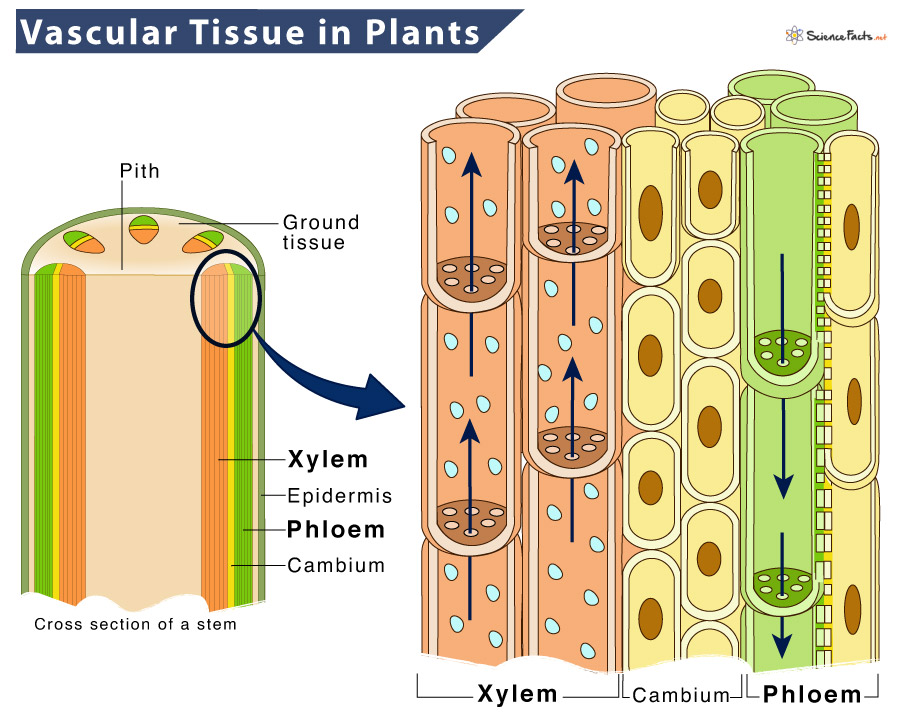Vascular Tissue in Plants
Vascular tissue is a specific type of tissue in plants that conduct water, minerals, and sugars to their different parts. In plants, they are xylem and phloem. Plants having a vascular system are called vascular plants.
Location of Vascular Tissue
Vascular tissue is found in all vegetative organs of a plant: the roots, the stems, and the leaves.
Not all plants have vascular tissue. Plants such as algae and bryophytes such as mosses, liverworts, and hornworts get water and minerals from their environment by simple diffusion. Thus, they are devoid of vascular tissue. In contrast, gymnosperms (mostly land plants) and ferns require vascular tissue to conduct water and minerals from the soil to all plant parts. Also, they transport the food produced by the leaf to the rest of the parts.
Where Does It Come From
Both xylem and phloem start as specialized tissue called cambium. Cambium cells are similar to stem cells that can divide into any tissue. Vascular tissue cells develop from vascular cambium. Cells of vascular cambium can become either xylem or phloem.
Types and Functions of Vascular Tissue
As we know, plants have two main types of vascular tissue: xylem and phloem.
1. Xylem
It is the vascular tissue transporting water and minerals from roots through the shoots to all parts of the plant. Xylem cells are dead cells forming a hollow cylinder, similar to a pipe that runs entirely from the roots to the leaves. Since xylem cells have thick cell walls, they also support the plant body.
The main conducting vessels of the xylem are the tracheids and the vessels. Tracheids are long thin tubes found in almost all vascular plants, while vessels are large tubes found primarily on angiosperms. The tracheids and vessels form pipes that have pores and perforated ends, allowing water and minerals to be transported from one tube to another and out to the surrounding tissues.
2. Phloem
It is the living, permanent tissue transporting sugars from the leaf to the rest of the plant. Phloem also carries various hormones and chemicals necessary for the growth and defense of the plant with the sap.
Unlike the xylem, which transports water and minerals in one direction (from the root to the leaves), the phloem conducts carbohydrates (sugars) in multiple directions. For example, phloem moves sugars from the leaves to the roots for storage and back to the leaves when they need them for cell division.
The primary conducting cells of phloem are sieve cells and sieve-tube members. Both cell types have many pores through which adjacent cells exchange different substances. Sieve tubes occur in angiosperms, while sieve cells are found in other vascular plants. In angiosperms, particular cell types called companion cells assign sieve tubes in their functioning.
The xylem and phloem are always located next to each other. In stems, the xylem and the phloem form the vascular bundle, while in roots, it is called the vascular stele or vascular cylinder.
Why is Vascular Tissue Important
Similar to the circulatory system that helps to distribute essential molecules to all parts of the human body, the presence of vascular tissue does the same thing in plants. It allows plants to transport water, minerals, and sap. Apart from its primary purpose of distribution, the arrangement of vascular tissue can also be used to differentiate between different angiosperms: monocots and dicots.
In Roots
The vascular tissue is arranged in the form of a ring around the pith in monocot roots, while in dicots, vascular tissue has an X-shaped arrangement.
In Stems
In monocot stems, the vascular bundles are randomly scattered throughout the ground tissue, while in dicots, they are arranged in a ring towards the stem periphery.
In woody dicots, the vascular tissue is more organized, with a vascular cambium layer having xylem on the inner side and phloem on the outer side. These layers produce seasonally, giving woody plants their seasonal rings.
In Leaves
Like all plant organs, leaves also contain vascular tissue. Monocots have parallel veins of vascular tissue in leaves. In contrast, dicots have branched or net-like veins of vascular tissue in the leaves.
FAQs
Ans. Conifers being vascular plants, they have vascular tissue.
Ans. No, fungi do not have vascular tissue.
-
References
Article was last reviewed on Thursday, July 28, 2022




